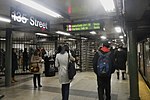Astor Row

Astor Row is the name given to 28 row houses on the south side of West 130th Street, between Fifth and Lenox Avenues in the Harlem neighborhood of Manhattan, New York City, which were among the first speculative townhouses built in the area. Designed by Charles Buek, the houses were built between 1880 and 1883 in three spurts, on land John Jacob Astor had purchased in 1844 for $10,000. Astor's grandson, William Backhouse Astor, Jr., was the driving force behind the development. The design of the three-story brick, single-family houses is unusual, in that they are set back from the street, and all have front and side yards – an oddity in Manhattan – as well as wooden porches. The first group of houses, numbers 8 through 22, comprises freestanding pairs, while the remainder, numbers 24 through 60, are connected together at the rear.The Astor Row houses were designated New York City Landmarks on August 11, 1981.
Excerpt from the Wikipedia article Astor Row (License: CC BY-SA 3.0, Authors, Images).Astor Row
West 130th Street, New York Manhattan
Geographical coordinates (GPS) Address Nearby Places Show on map
Geographical coordinates (GPS)
| Latitude | Longitude |
|---|---|
| N 40.81045 ° | E -73.941987 ° |
Address
West 130th Street 53
10037 New York, Manhattan
New York, United States
Open on Google Maps







